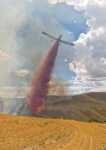Battle from the air: Air tanker pilots reflect on fire fighting mission

A steady blast of water shot from the washer as the crew continued to scrub away the dirt off the aircraft parked on the taxiway at the Mountain Home Airport. The team ran brushes across the fuselage and along the wings, all of which had a thin layer of grime left over from missions flown the previous day.
However, the goal that morning was to scour away the red-tinged residue that had collected around the belly of the aircraft. It was the tell-tale sign that the plane had seen its fair share of action in recent weeks.
Since last week, the missions had taken the aircraft and others like it northwest of Mountain Home toward Boise and Idaho City. Each time they launched, their goal was to help contain a series of range fires that continue to rage out of control across this part of the state.
At the helm of these single-engine planes are people like Greg Schultz and Josh Pavia, who represent a select group of pilots who fly these single engine air tankers, commonly known as SEAT aircraft. Each spring, they are called up to support the Bureau of Land Management and U.S. Forest Service to battle range fires across the United States.
This summer, this mission took Schultz and Pavia to Mountain Home, where they continue to fly missions to contain a series of range fires that have scorched thousands of acres in parts of Ada County.
In addition to being accomplished pilots, those selected to fly these SEAT aircraft tend to have more specific qualifications. Many of them have backgrounds flying crop dusters while others have spent considerable time flying over mountain passes similar to those in southern Idaho.
When fully loaded, a SEAT aircraft carries 800 gallons of the bright red flame retardant. It takes less than a second to empty that tank.
SEAT aircraft have their own unique quirks, according to Pavia. For example, the tanker's heavy tail weight and more powerful engine makes it more challenging to fly compared to other single-engine aircraft owned by other private pilots.
"You have to be ahead of the aircraft," said Pavia as he emphasized the need to anticipate how these tankers will fly, especially during takeoffs and landings.
The goal of these pilots is to disperse the retardant they carry over an area of an advancing fire. It's a process commonly known to as "painting" the target -- a euphemism that refers to the red dye in the retardant.
With range fires capable of spreading across several miles, there's no way a SEAT aircraft can extinguish a fire from the air. But that's not the objective.
Their goal is to knock down the flames from an approaching fire. This gives firefighters on the ground the time they need to safely get ahead of the flames.
"The retardant slows down the flames enough so the guys on the ground can get in," Pavia said. "We're hoping to help them out one way or another."
SEAT crews avoid hitting the fire where it's the hottest. That strategy doesn't work because the extreme heat would cause the retardant to evaporate before it hit the ground, rendering it useless, according to Schultz.
While most private pilots would normally avoid flying anywhere near a forest fire, the SEAT pilots need to get as close as they can to the flames. Despite that challenge, the missions over the fire remain fairly routine since the air currents over the approaching flames are fairly stable, according to Schultz.
"You get beat up more flying to and from the fire," he said.
While most missions are usually routine, it's the ones where lives are on the line that stand out, said Schultz, who followed in his father's footsteps by flying crop dusters when he was younger.
The most memorable for him happened in the community of Princeton, Minn., which is home to nearly 4,700 people. A group of children triggered a brush fire while they were trying to drive gophers out of a turkey pasture.
High winds fanned the flames and cause the fire to spread into a grove of pine trees which then ignited. As people tried to escape, their cars were blocking the narrow roadways, hampering efforts of fire fighters to reach the fire.
Schultz and his team were the first in the air. In what was a breach of protocol, the lead pilot called the team saying the flames had reached a children's nursery, trapping everyone inside.
He didn't hesitate for a moment. As the wheels of the tanker left the runway, Schultz forced the aircraft to take a hard turn and flew toward the flames, which were now circling the building.
With the red retardant spewing from the belly of the aircraft, it knocked down the flames and allowed the children and adults to safely escape. While the fire destroyed a number of buildings in that small town that day, Schultz emphasized that no one died.
Normally, aircrews don't intentionally drop fire retardant on homes and other buildings, but there are exceptions to that rule. Among them happened four years ago when Schultz and his team were battling fires outside of Denver that had already destroyed a number of homes and other buildings.
Due to the size and magnitude of this fire, crews in the air made an exception and painted every structure directly threatened by the approaching wall of flames.
"The goal is to make it safer for the guys on the ground," Schultz said.
While these pilots know they're flying into harm's way each time they launch, they don't spend their time in the air worrying about themselves, according to Pavia.
"You're thinking about the guys on the ground and making sure they're safe," he said.
